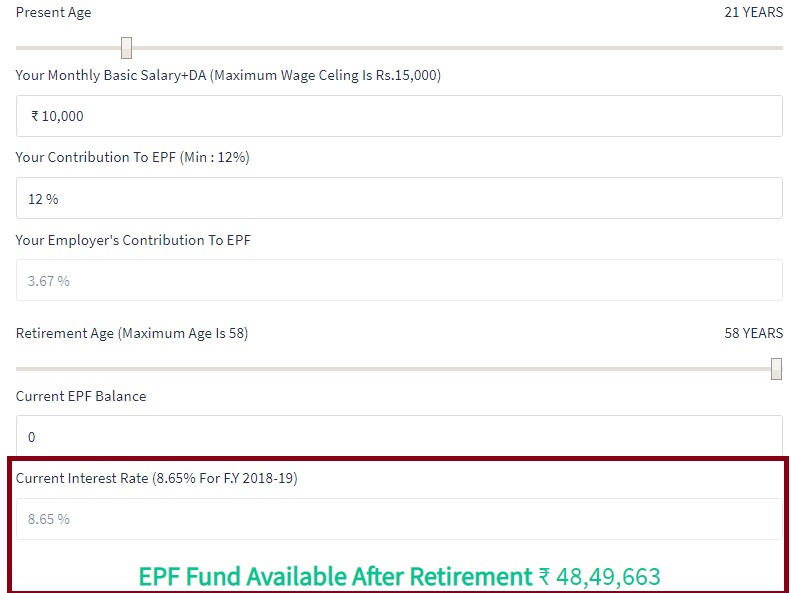Salaried employee? Retire rich! EPFO hikes Employee Provident Fund (EPF) interest rate to 8.65% - Calculate your gains
When an employee is retired, they get an fixed income for their service. EPF is among the traditional investment options for employees.

Ahead of the elections, the NDA government through its Employees’ Provident Fund Organisation (EPFO) has given a gift to salaried employees by hiking interest rate on provident fund. The decision was taken in 224th meeting of the Central Board of Trustees, held on Thursday, under the chairmanship of Union Minister of State for Labour and Employment (I/C) Santosh Kumar Gangwar. In this meeting, EPF interest rates were hiked to 8.65 % from 8.55%. This would be 10 basis point rise in EPF. Notably, 8.65% interest rate is similar to what employees enjoyed in fiscal FY17, however, still lower to 8.8% rate of FY16. But, definitely now your gains on EPF will be more during retirement. Let's find out how!
Know your Employee Provident Fund (EPF)!
Currently, an employee is asked to contribute 12% of their basic salary plus dearness allowance in EPF.
On the other hand, an employer contributes only 3.67% towards EPF, while remaining 8.33% is added in your employee pension scheme.
Contribution is rounded to the nearest rupee for each employee, for the employee share, pension contribution and EDLI contribution. The Employer Share is difference of the EE Share (payable as per statute) and Pension Contribution. Notably, contributions are payable on maximum wage ceiling of Rs 15,000. However, the employee can pay at a higher rate and in such case employer is not under any obligation to pay at such higher rate.
Your employer’s contribution in your EPF is tax-free, however, your contribution is tax-deductible under section 80 of Income Tax Act. This section allows you to claim about Rs 1.5 lakh tax exemption from your gains. However, there are few tax deducted at source (TDS) on the interest your earn on EPF investment.
If you have withdrawn over Rs 50,000 before completion of 5 years, then TDS is applicable. However, if less than Rs 50,000 is withdrawn before 5 years of completion, then a TDS of 10% is furnished.
There are no TDS levied on withdrawal after 5 years, or transfer of PF account.
Let's calculate:
For instance, at the age of 21, your monthly basic salary plus dearness allowance stands at Rs 10,000 - from which you contribute 12%. Meanwhile, your employer contributes 3.67%. You have taken the retirement age of 58 years. Then post retirement, you will take home a massive over Rs 72.76 lakh.

(Image Source: ClearTax Calculator)
Similarly, if your basic salary plus dearness allowance is at Rs 10,000 per month, from which you contribute 12% in EPF, while your employer gives in 3.67%. You have selected the retirement age as 58. Here, you will take home over Rs 48.49 lakh.

(Image Source: ClearTax Calculator)
Take note, the more early age you start working, the higher will be your EPF gains on retirement.Generally, a youth begins working from the age of 21 in India, after graduation. Hence, this is best opportunity for such young generation to have a good savings for their retirement. Notably, EPF is still better than traditional format of investment like fixed deposits, term deposits, etc.
The EPFO does allow higher salary class to avail benefits of EPFO. To pay contribution on higher wages, a joint request from Employee and employer is required.
Get Latest Business News, Stock Market Updates and Videos; Check your tax outgo through Income Tax Calculator and save money through our Personal Finance coverage. Check Business Breaking News Live on Zee Business Twitter and Facebook. Subscribe on YouTube.
RECOMMENDED STORIES

Fundamental picks by brokerage: These 3 largecap, 2 midcap stocks can give up to 28% return - Check targets

SBI Senior Citizen Latest FD Rates: What senior citizens can get on Rs 7 lakh, Rs 14 lakh, and Rs 21 lakh investments in Amrit Vrishti, 1-, 3-, and 5-year fixed deposits

Tamil Nadu Weather Alert: Chennai may receive heavy rains; IMD issues yellow & orange alerts in these districts

SIP+SWP: Rs 10,000 monthly SIP for 20 years, Rs 25 lakh lump sum investment, then Rs 2.15 lakh monthly income for 25 years; see expert calculations

Top 7 Mutual Funds With Highest Returns in 10 Years: Rs 10 lakh investment in No 1 scheme has turned into Rs 79,46,160 in 10 years

SIP vs PPF: How much corpus you can build in 15 years by investing Rs 1.5 lakh per year? Understand through calculations

Retirement Planning: Investment Rs 20 lakh, retirement corpus goal Rs 3.40 crore; know how you can achieve it
11:08 AM IST










 Does an employer stop EPF contributions if the employee becomes a senior citizen?
Does an employer stop EPF contributions if the employee becomes a senior citizen? Employees Provident Fund: All you need to know about login, EPF balance, interest rate and other details
Employees Provident Fund: All you need to know about login, EPF balance, interest rate and other details EPFO: PF amount displayed in salary slip didn't reach your PF account; here’s what you can do
EPFO: PF amount displayed in salary slip didn't reach your PF account; here’s what you can do Employee Provident Fund vs Public Provident Fund: EPF or PPF - where can investors earn higher interest rate?
Employee Provident Fund vs Public Provident Fund: EPF or PPF - where can investors earn higher interest rate? PF Account Balance: Here is how to check PF balance via SMS, Phone number, UMANG app, and EPFO portal
PF Account Balance: Here is how to check PF balance via SMS, Phone number, UMANG app, and EPFO portal